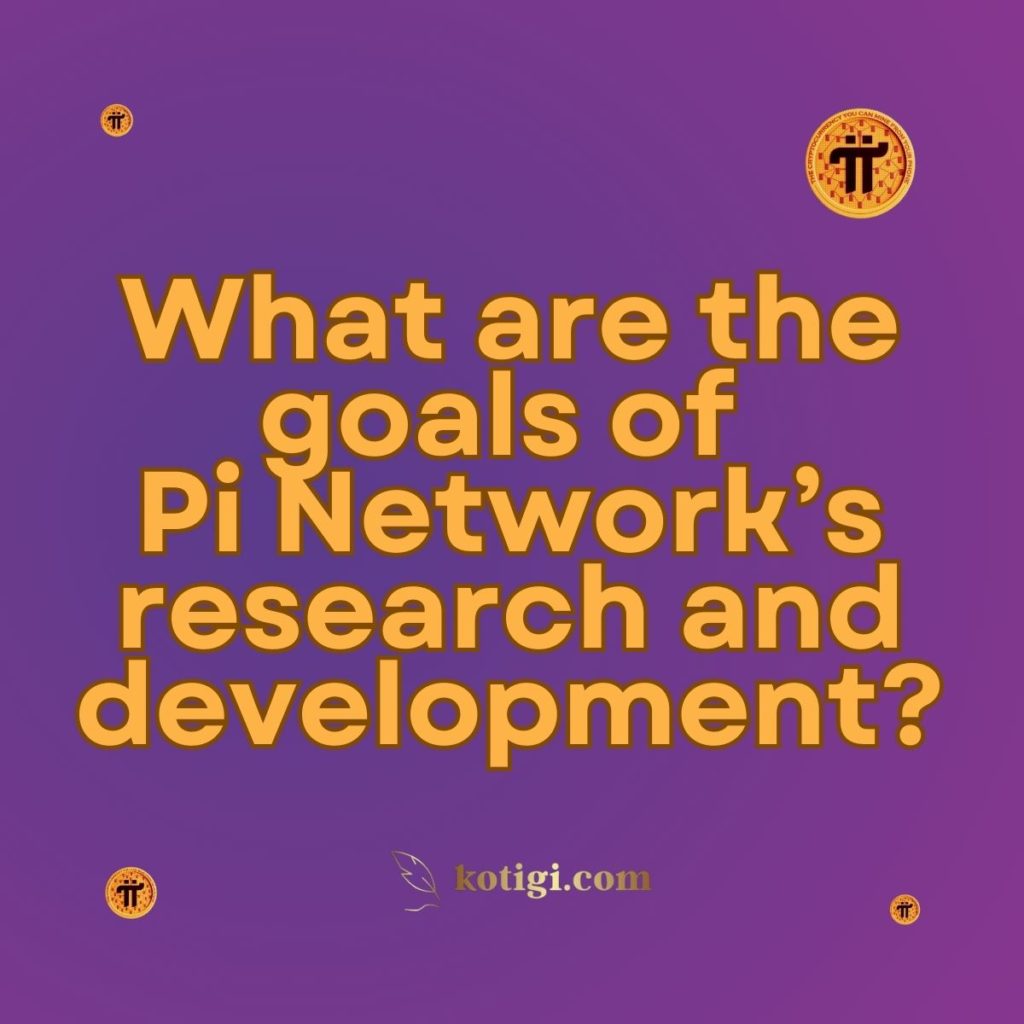
What are the goals of Pi Network’s research and development?
Pi Network’s research and development efforts are focused on creating a secure, scalable, and user-friendly cryptocurrency ecosystem. By prioritizing technological innovation, community engagement, and strategic partnerships, Pi Network aims to establish itself as a leader in the blockchain space while enhancing the overall user experience.
Introduction
The cryptocurrency landscape is constantly evolving, and the success of any project relies heavily on robust research and development (R&D) efforts. Pi Network recognizes this and has set ambitious goals to drive innovation and technological advancement. This article explores the key objectives of Pi Network’s research and development initiatives, emphasizing their commitment to building a secure, scalable, and user-centric ecosystem. By focusing on these goals, Pi Network aims to establish itself as a leader in the cryptocurrency space and provide significant value to its community.
1. Enhancing Security
1.1 Implementing Robust Security Protocols
One of the primary goals of Pi Network’s R&D is to enhance the security of its platform. As cyber threats continue to evolve, the network prioritizes implementing robust security protocols that protect user data and assets. This includes developing advanced encryption methods and multi-factor authentication processes to safeguard user accounts and transactions.
1.2 Conducting Regular Security Audits
Regular security audits are crucial for identifying vulnerabilities and ensuring the integrity of the platform. Pi Network’s R&D team is dedicated to conducting thorough security assessments, both internally and through third-party evaluations. These audits help the network stay ahead of potential threats and maintain user trust.
1.3 Creating a Resilient Infrastructure
A secure cryptocurrency ecosystem requires a resilient infrastructure capable of withstanding various types of attacks. Pi Network aims to develop a decentralized and fault-tolerant infrastructure that minimizes downtime and ensures continuous operation, thereby enhancing user confidence in the platform.
2. Achieving Scalability
2.1 Optimizing Network Performance
Scalability is a critical factor for the long-term success of any cryptocurrency. Pi Network’s R&D focuses on optimizing network performance to handle an increasing number of users and transactions without compromising speed or efficiency. By refining its consensus algorithm and transaction validation processes, Pi Network aims to ensure a seamless user experience even as demand grows.
2.2 Implementing Layer 2 Solutions
To further enhance scalability, Pi Network is exploring the implementation of Layer 2 solutions that enable faster transactions and reduced congestion on the main blockchain. These solutions can help improve overall network capacity while minimizing transaction costs, making the platform more attractive to users and developers alike.
2.3 Conducting Load Testing
Regular load testing is essential for identifying performance bottlenecks and ensuring the network can handle increased traffic. Pi Network’s R&D team conducts extensive load testing to simulate high-traffic scenarios and identify areas for improvement, ensuring the platform remains robust under various conditions.
3. Fostering User Experience
3.1 Developing User-Friendly Interfaces
A primary goal of Pi Network’s R&D is to create user-friendly interfaces that simplify the process of using the platform. By focusing on intuitive design principles, the network aims to make it easy for users, regardless of their technical background, to navigate the platform and engage with its features.
3.2 Gathering User Feedback
User feedback is invaluable for refining the platform and enhancing user experience. Pi Network actively solicits feedback from its community to identify pain points and areas for improvement. This feedback loop ensures that the platform evolves in line with user needs and expectations.
3.3 Providing Educational Resources
To empower users and facilitate a better understanding of the platform, Pi Network invests in educational resources, including tutorials, webinars, and documentation. By helping users navigate the complexities of cryptocurrency, Pi Network fosters a more engaged and informed community.
4. Promoting Interoperability
4.1 Building Cross-Chain Solutions
Interoperability is essential for creating a seamless cryptocurrency ecosystem. Pi Network’s R&D efforts focus on developing cross-chain solutions that enable users to interact with other blockchain networks. By facilitating interoperability, Pi Network can expand its user base and enhance the overall utility of its tokens.
4.2 Collaborating with Other Projects
Strategic partnerships with other blockchain projects can enhance interoperability and create a more integrated ecosystem. Pi Network actively seeks collaborations that align with its vision and goals, enabling users to leverage the strengths of multiple platforms.
4.3 Standardizing Protocols
Developing standardized protocols for cross-chain interactions is another goal of Pi Network’s R&D. By establishing common standards, the network can facilitate seamless communication between different blockchains, enhancing user experience and promoting adoption.
5. Driving Technological Innovation
5.1 Researching Emerging Technologies
To stay at the forefront of the cryptocurrency space, Pi Network invests in researching emerging technologies that can enhance its platform. This includes exploring advancements in artificial intelligence, machine learning, and decentralized finance (DeFi) to identify opportunities for innovation and growth.
5.2 Experimenting with New Features
The R&D team is dedicated to experimenting with new features and functionalities that can enhance the overall user experience. By testing innovative ideas and gathering user feedback, Pi Network can refine its offerings and stay ahead of competitors.
5.3 Staying Agile and Adaptable
The cryptocurrency landscape is dynamic and constantly evolving. Pi Network aims to remain agile and adaptable in its approach to research and development, allowing it to pivot quickly in response to changing market conditions and user needs.
6. Supporting Developers
6.1 Providing Development Tools
To encourage third-party developers to build on the Pi Network platform, the R&D team is focused on creating comprehensive development tools and resources. This includes APIs, SDKs, and documentation that make it easy for developers to integrate their applications with the Pi Network.
6.2 Establishing a Developer Community
Building a strong developer community is essential for fostering innovation and collaboration. Pi Network actively engages with developers through forums, hackathons, and workshops to encourage knowledge sharing and idea generation.
6.3 Offering Incentives for Development
To attract developers to the Pi Network ecosystem, the R&D team explores various incentive structures that reward developers for their contributions. This can include grants, token rewards, or access to exclusive resources, creating a thriving environment for innovation.
Conclusion
Pi Network’s research and development goals are centered around enhancing security, achieving scalability, fostering user experience, promoting interoperability, driving technological innovation, and supporting developers. By focusing on these objectives, Pi Network aims to build a robust and user-friendly cryptocurrency ecosystem that meets the evolving needs of its community. As the project continues to develop, its commitment to research and development will play a crucial role in its long-term success and positioning within the competitive cryptocurrency landscape.
Key Takeaways
- Enhanced Security: Pi Network prioritizes implementing robust security protocols and conducting regular audits to protect user data and assets.
- Scalability Efforts: The network focuses on optimizing performance and exploring Layer 2 solutions to accommodate growing user demand.
- User-Centric Design: Developing user-friendly interfaces and gathering feedback helps improve the overall user experience on the platform.
- Interoperability Initiatives: Building cross-chain solutions and collaborating with other projects promotes seamless interaction within the cryptocurrency ecosystem.
- Innovation and Development: Researching emerging technologies and supporting developers fosters a culture of innovation within the Pi Network community.
- Community Engagement: Actively engaging with users and developers ensures that the platform evolves in alignment with user needs and expectations.





